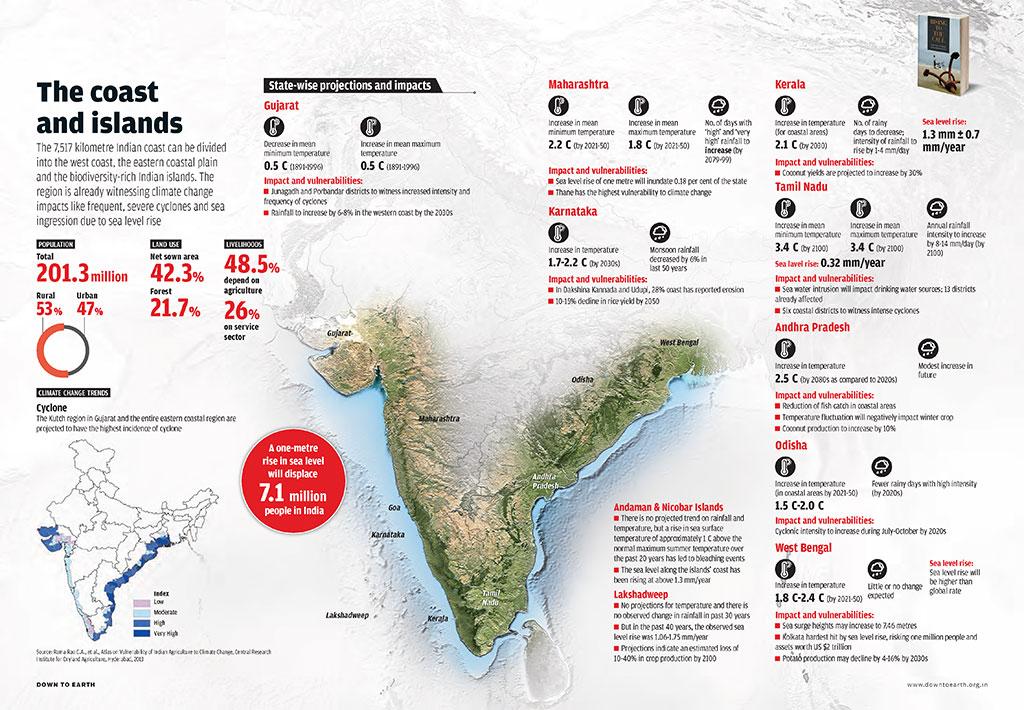Note4Students
From UPSC perspective, the following things are important :
Prelims level: Environmental Impact Assessment
Mains level: Paper 3- Climate change and its impact on India
Context
In the absence of COVID-19, climate change-induced disasters would have been India’s biggest red alert in recent years.
India’s vulnerabilities

- Temperatures over the Indian Ocean have risen by over 1°C since the 1950s, increasing extreme weather events.
- India is the fourth worst-hit in climate migration.
- Heat waves in India have claimed an estimated 17,000 lives since the 1970s.
- Labour losses from rising heat, by one estimate, could reach ₹1.6 lakh crore annually if global warming exceeds 2°C, with India among the hardest hit.
- Extreme heat waves hit swathes of India. Heatwaves are aggravated by deforestation and land degradation, which also exacerbate fires.
- Agriculture, being water-intensive, does not do well in heat wave-prone areas.
Way forward
- Two part approach: India needs a two-part approach:
- Adaptation: one, to adapt to climate impacts by building resilience against weather extremes, and
- Mitigation: to mitigate environmental destruction to prevent climate change from becoming more lethal.
- Climate resistant agriculture: Agricultural practices which are not water-intensive and to support afforestation that has a salutary effect on warming.
- Financial transfers can be targeted to help farmers plant trees and buy equipment — for example, for drip irrigation that reduces heavy water usage.
- Crop diversification: Climate-resilient agriculture calls for diversification — for example, the cultivation of multiple crops on the same farm.
- Climate-resilient agriculture calls for diversification — for example, the cultivation of multiple crops on the same farm
- Managing vulnerable regions in coastal zones: Floods and storms are worsened by vast sea ingress and coastline erosion in the low-lying areas in the south.
- It is vital to map flood-risk zones to manage vulnerable regions.
- Environment Impact Assessments must be mandatory for commercial projects.
- Design changes: Communities can build round-shaped houses, considering optimum aerodynamic orientation to reduce the strength of the winds.
- Roofs with multiple slopes can stand well in strong winds, and central shafts reduce wind pressure on the roof by sucking in air from outside.
- Moving away from fossil fuels: Adaptation alone will not slow climate damages if the warming of the sea level temperatures is not confronted.
- Leading emitters, including India, must move away from fossil fuels.
- Expanding and protecting forest cover: a big part of climate action lies in protecting and expanding forest coverage.
- India gains from being part of the Glasgow declaration on forest protection that 141 countries signed in 2021.
- Management of dams: Nearly 295 dams in India are more than 100 years old and need repairs.
- In stemming landslides in Uttarakhand, regulations must stop the building of dams on steep slopes and eco-fragile areas, as well as the dynamiting of hills, sand mining, and quarrying.
- Climate financing: India’s share in disaster management should be raised to 2.5% of GDP.
- Climate finance is most suited for large-scale global funding from the World Bank, the International Monetary Fund, and the Asian Development Bank.
- But smaller-scale financing can also be vital.
Conclusion
For public pressure to drive climate action, we need to consider climate catastrophes as largely man-made.
Get an IAS/IPS ranker as your 1: 1 personal mentor for UPSC 2024
